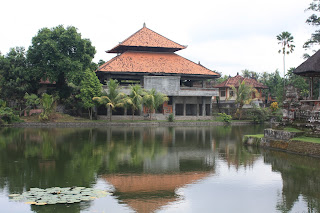We
booked Made for a trip to the Tabanan area today, and it was a good choice.
Between our suggestions and his revisions and additions to our route, we had
another great day.
It
started with a visit to Pura Taman Ayun. So far as we can gather this temple
was built in 1634 by a king of Mengwi as a royal family temple. The temple is
surrounded by a moat…..or maybe two moats…..we couldn’t quite tell. We believe
that there are shrines here to the mountain deities and others as well as to
important kings of Mengwi. Walking around we appreciated the beautifully
maintained and stunning gardens, and the amazing architecture, and as I do some
research to write this blog I learn that the name means “beautiful garden” and
that it is one of the most attractive temples in Bali, with which we would
agree. The other interesting part was the cock fighting pavilion. You
don’t imagine the Bali men being into blood and gore, but cock fighting is an
ancient Balinese tradition and still plays an important part in their lives. In
the country villages, and along road sides you see wicker baskets filled with
proud and colourful roosters. These are the fighters! It is apparently illegal,
but when it is associated with the temple it is an exception. Cock fights are
often staged before temple ceremonies as offerings to the Gods. We haven’t
attempted to see one of these violent games, but it is as much a part of the
culture as the soft spoken words of welcome and the “feel good” atmosphere.
Our
next stop was the Margarana Memorial about 6 k from Belayu in a small town
called Marga. On November 20, 1946 the Republic of Indonesia represented by a
regiment of guerrilla fighters, fought a bloody battle against the Dutch after
the fall of the Japanese occupation under the commandership of Lieutenant
Colonel I Gusti Ngurah Rai. Ngurah Rai and all his 94 troops were killed. The
ashes of these great heroes are buried in the cemetery. The battle is known as
the War of Puputan Margarana. Just outside the gardens were 94 headstones each
naming the name and home village of the dead hero. Bali’s airport and Denpasar
university are named in honour of Ngurah Rai.
This
was obviously not a very popular tourist site, and the grounds and
infrastructure were in bad need of repair. Nonetheless, it was a beautiful
spot, with lovely gardens and made a peaceful tribute to the people who had
fought to save Indonesia (Bali) from Dutch rule.
We
continued north up a little road to Pura Luhur Batukau, one of Bali’s most
“venerated” temples – the Temple of the Stone Coconut Shell. It was quite
lovely. Set on the side of a mountain it was quiet and beautiful. I think you
can see the setting from the video of a ceremony that was taking place but
which we were unable to attend.
We left
this beautiful temple and headed back south for a few km before turning off
onto a twisting, bumpy, narrow, country road leading from Wongaya Gede to the
village of Jatiluwih. I was glad this was Made’s choice and not ours!! I felt
for his SUV!! We were suddenly in the middle of the rice fields. The scenery
was so breathtaking that Made stopped the car and we got out and walked. This
was one of the prettiest drives we had been on. The village itself was touristy,
but the country around was quiet and stunning.
It was
a truly beautiful day. The scenery was lovely, the temples some of the best we
have seen, and it was nice to ground all of this with a little bit of the
history of the island. Living in the West I have been very ignorant of the part
these countries played in the WWI and II.






































No comments:
Post a Comment